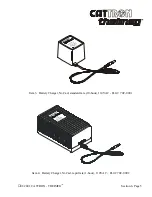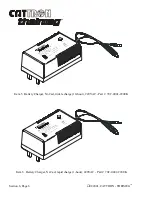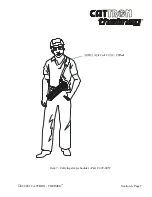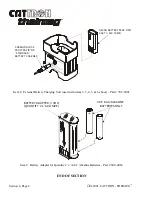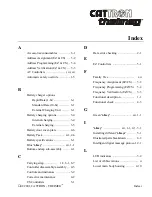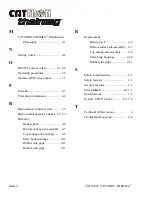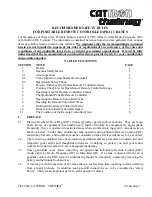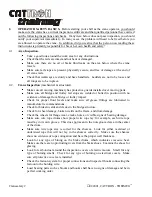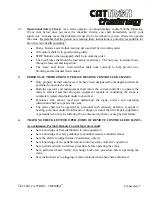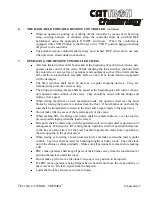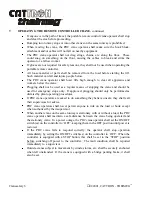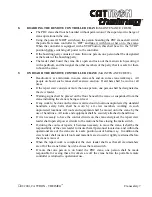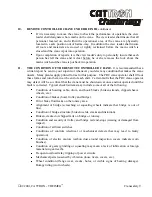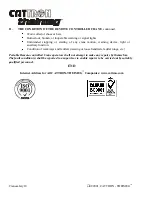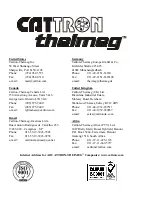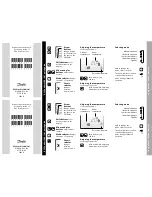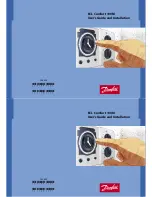
01/2001, CATTRON
- THEIMEG
TM
Cranesafety 9
10. REMOTE CONTROLLED CRANE UNDER REPAIR
, continued.
+
If it is necessary to move the crane to check the performance of operation, the crew
leader shall designate who remains on the crane. The crew leader shall insure that all
personnel located on, and within the operational area of the crane are physically
located in a safe position out of harms-way. In addition the crew leader shall insure
all tools and materials are stowed or tightly restrained before the main switch is
closed and the crane is put into operation.
+
Upon completion of repairs, it is the crew leader's duty to personally insure that each
person has left the crane and is clear before he or she removes the lock above the
main switch and the crane is put back in operation.
11. THE CONDITION OF THE REMOTE CONTROLLED CRANE.
It is recommended that a
written report be sent to your supervisor whenever you detect any condition that makes the crane
unsafe. Many plants supply printed forms for this purpose. The PRC crane operator shall fill out
these forms and turn them in at the end of each shift. Certain faults that the PRC crane operator
may detect will be so critical that the crane must be shut down at once and not operated until the
fault is corrected. Typical checklist items may include some or all of the following:
+
Condition of hoisting cable, drum, and hook blocks (broken strands, clipped sheave
wheels, etc.).
+
Condition of brakes (hoist, trolley and bridge).
+
Oil or brake fluid leaks on the runway area.
+
Alignment of bridge (screeching or squealing wheels indicate that bridge is out of
line).
+
Condition of bridge structure (broken welds, cracks and distortion).
+
Broken, cracked or chipped rails on bridge or runway.
+
Condition and security of trolley and bridge rail end-stops (missing or damaged from
impact).
+
Condition of all limit switches.
+
Conditions of controls (electrical or mechanical defects that may lead to faulty
operation).
+
Condition of electric motors (carbon dust around inspection covers indicate worn
brushes).
+
Condition of gears (grinding or squealing may mean a lack of lubrication or foreign
materials in gear teeth).
+
Frequent overload relay tripping of power circuits.
+
Mechanical parts loosened by vibration (loose rivets, covers, etc.).
+
Wheel condition (flange wear, cracks, holes, or visible signs of bearing damage).
Bumpy riding (worn wheels).
Summary of Contents for i-Key
Page 2: ......
Page 14: ...Page xii 01 2001 CATTRON THEIMEG TM EZ CS AT Rx Rx Tx Tx Tx Rx Rx Rx ...
Page 20: ...Section 1 Page 6 01 2001 CATTRON THEIMEG TM This page intentionally left blank ...
Page 44: ...Section 4 Page 4 01 2001 CATTRON THEIMEG TM ...
Page 52: ...Section 4 Page 12 01 2001 CATTRON THEIMEG TM This page intentionally left blank ...
Page 68: ...Section 5 Page 16 01 2001 CATTRON THEIMEG TM This page intentionally left blank ...
Page 75: ... 01 2001 CATTRON THEIMEG TM Section 6 Page 7 Item 7 Carrying strap shoulder Part 42C 0057 ...
Page 89: ......

